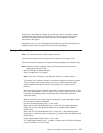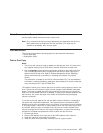
Configure Surveillance Policy
Note: This service aid runs on CHRP system units only. This service aid is only
supported for systems running in full machine partition.
This service aid monitors the system for hang conditions; that is, hardware or software
failures that cause operating system inactivity. When enabled, and surveillance detects
operating system inactivity, a call is placed to report the failure.
Use this service aid to display and change the following settings for the Surveillance
Policy:
Note: Because of system capability, some of the following settings might not be
displayed by this service aid:
v Surveillance (on/off)
v Surveillance Time Interval
This is the maximum time between heartbeats from the operating system.
v Surveillance Time Delay
This is the time to delay between when the operating system is in control and when
to begin operating system surveillance.
v Changes are to Take Effect Immediately
Set this to Yes if the changes made to the settings in this menu are to take place
immediately. Otherwise the changes take effect beginning with the next system boot.
You can access this service aid directly from the AIX command line, by typing:
/usr/lpp/diagnostics/bin/uspchrp -s
Create Customized Configuration Diskette
This selection invokes the Diagnostic Package Utility Service Aid, which allows the user
to create a standalone diagnostic package configuration diskette.
The Standalone Diagnostic Package Configuration Diskette allows the following to be
changed from the console:
v Default refresh rate for a low function terminal (LFT)
The refresh rate used by the standalone diagnostic package is 60 Hz. If the display’s
refresh rate is 77 Hz, set the refresh rate to 77.
v Different async terminal console
You can create a console configuration file that allows a terminal attached to any
RS232 or RS422 adapter to be selected as a console device. The default device is
an RS232 TTY device attached to the first standard serial port (S1).
106 Eserver pSeries 690 User’s Guide


















